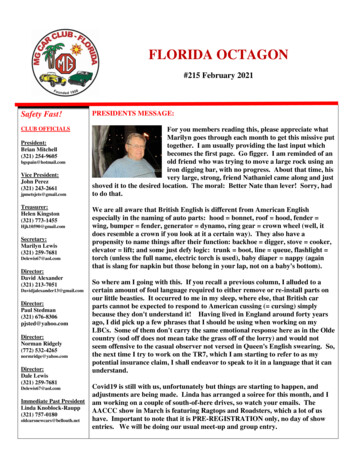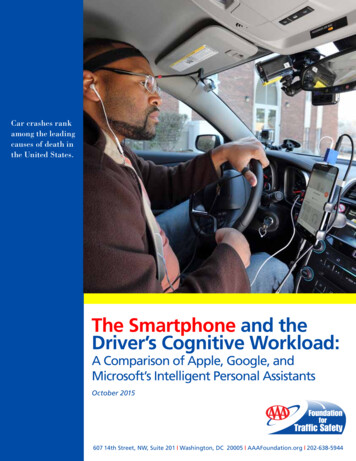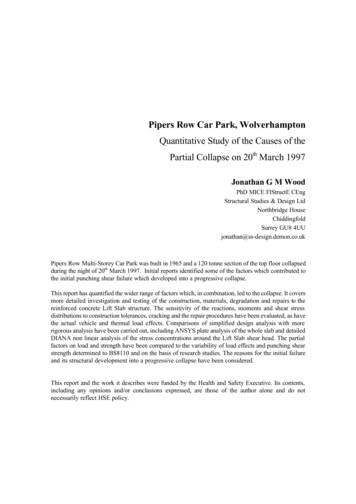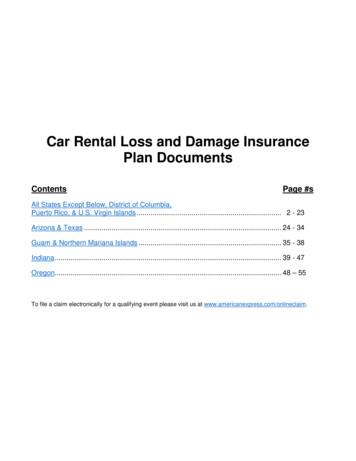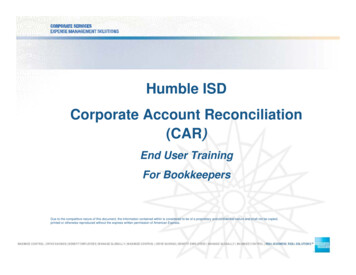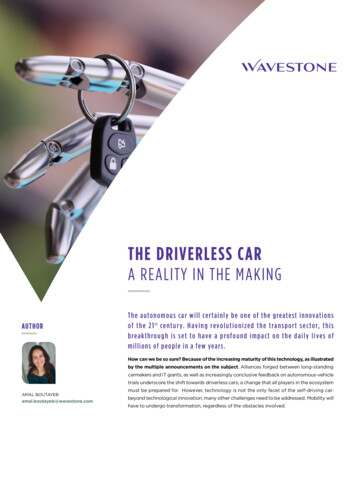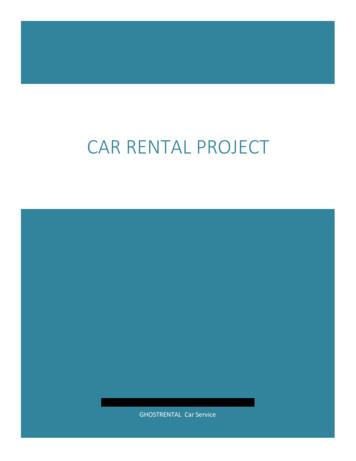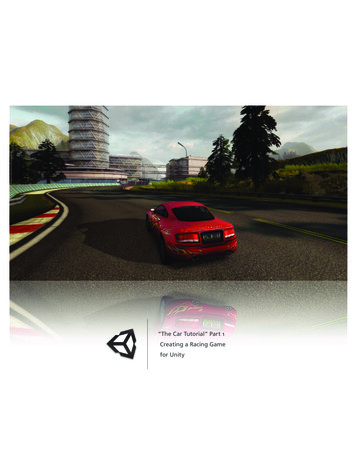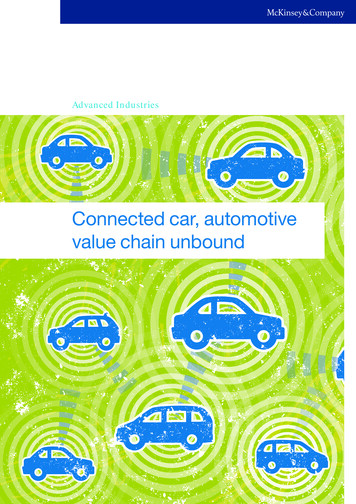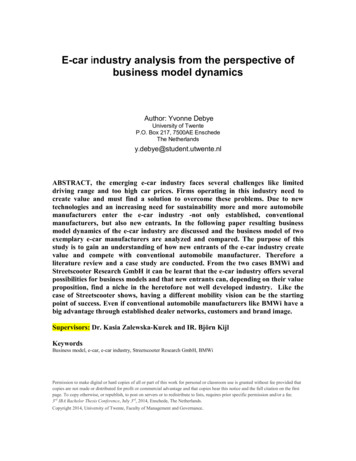
Transcription
E-car industry analysis from the perspective ofbusiness model dynamicsAuthor: Yvonne DebyeUniversity of TwenteP.O. Box 217, 7500AE EnschedeThe Netherlandsy.debye@student.utwente.nlABSTRACT, the emerging e-car industry faces several challenges like limiteddriving range and too high car prices. Firms operating in this industry need tocreate value and must find a solution to overcome these problems. Due to newtechnologies and an increasing need for sustainability more and more automobilemanufacturers enter the e-car industry -not only established, conventionalmanufacturers, but also new entrants. In the following paper resulting businessmodel dynamics of the e-car industry are discussed and the business model of twoexemplary e-car manufacturers are analyzed and compared. The purpose of thisstudy is to gain an understanding of how new entrants of the e-car industry createvalue and compete with conventional automobile manufacturer. Therefore aliterature review and a case study are conducted. From the two cases BMWi andStreetscooter Research GmbH it can be learnt that the e-car industry offers severalpossibilities for business models and that new entrants can, depending on their valueproposition, find a niche in the heretofore not well developed industry. Like thecase of Streetscooter shows, having a different mobility vision can be the startingpoint of success. Even if conventional automobile manufacturers like BMWi have abig advantage through established dealer networks, customers and brand image.Supervisors: Dr. Kasia Zalewska-Kurek and IR. Björn KijlKeywordsBusiness model, e-car, e-car industry, Streetscooter Research GmbH, BMWiPermission to make digital or hard copies of all or part of this work for personal or classroom use is granted without fee provided thatcopies are not made or distributed for profit or commercial advantage and that copies bear this notice and the full citation on the firstpage. To copy otherwise, or republish, to post on servers or to redistribute to lists, requires prior specific permission and/or a fee.3rd IBA Bachelor Thesis Conference, July 3rd, 2014, Enschede, The Netherlands.Copyright 2014, University of Twente, Faculty of Management and Governance.
1. INTRODUCTIONIn today‘s fast developing world and economies industrybusiness models are changing quickly. In the last decadeespecially in the automobile industry huge shifts areperceivable. Due to finite resources (Kottler, 2011), theincreasing price of oil (Becker et al., 2009; Sadek, 2012) andincreasing ecological awareness (Gadenne et al., 2009) a lot ofautomobile manufacturers try to access the electric car marketto meet the customer‘s demand of sustainable technologies(Chan, 2007). The whole car industry is on a technologicalmove (Bozem et al., 2013). In the automobile industry not onlyengine concepts change but rather the business model conceptsalter (Maxton, 2004; Chan, 2007) and as well ‗constructions ofcomplex social networks‘ (Kond and Bi, 2014, p.1). Theretoexisting know-how must be applied in a completely new way(Stricker et al., 2011).The 125 year old industry (Indra, 2012) converts and next toconventional car manufacturers like Audi, BMW andMercedes-Benz (Siebenhüter and Meyer, 2011; Indra 2012)trying to enter the fast developing e-car market, also newsmaller firms and start-ups are involved in capturing the market(Freyssenet, 2009). Generally an exceeding entering ofmanufacturers in the market can be expected (Kley et al., 2011)Former automobile manufacturer seek to find a way to keeppace with the technological innovations and new businessconcepts whereas new companies try to enter the highlycompetitive market with new business concepts.This thesis will draw on the new situation in the automotiveindustry where a relatively young manufacturer calledStreetscooter Research GmbH can compete with big carmakersor can find a niche in the e-car industry. Therefore, in thispaper, as a case study, their business models will be analyzedand compared to the one of BMWi.People involved in the automobile industry and especially in thee-car industry can experience examples of business modelswithin the e-car industry and learn how a new entrants canpenetrate a market and how established player in the automobileindustry renew parts of their business model (in this case:starting a new sub brand) to be up-dated within the industry.Thus, the central question to be examined in this paper is:How do new entrants of the e-car industry create valuecompared to conventional automobile manufacturers?The study will begin by outlining the theoretical framework. Itis explained what business models and business modeldynamics are and why business model innovation is essential.Then it is shown how business models can be analyzed andcompared with the help of business model frameworks.Afterwards frameworks to explore macro environment ofindustries and the methodology are given. In the analysis partthe dynamics of the e-car industry are explained and differentcommon business models are presented. Then the businessmodels of BMWi and Streetscooter are elaborated andcompared and a macro-environment analysis of the twocompanies are given. Finally discussion and conclusion areelaborated and limitations and further research are remarked.2. THEORETICAL FRAMEWORK2.1 Business ModelsJohnson et al. (2008) mention that ―Business model innovationshave reshaped entire industries and redistributed billions ofdollars of value‖ (p.59). A good conceived business model iscrucial for every institution regardless whether it is a newentrant or an entrenched business in the market (Magretta,2002). It combines the potential of technology with commercialvalue and releases financial worth from technology(Chesbrough and Rosenbloom, 2002). According toChesbrough and Rosenbloom (2002) is ―the ultimate role of thebusiness model to ensure [ ]‖ that it ―delivers value to thecustomer‖ (p.529). It should be better than the previousobjective and the target ought to be that the new business modelbecomes a standard and challenges next generation enterprisers(Magretta, 2002). Hence, ―creating a new business model is[ ] like writing a new story‖ (Magretta, 2002, p. 4) anddesigning it can be seen as art (Teece, 2010).Thus, after finding a successful and working business modelone should always keep in mind that ―business models are oftenquite transparent and [ ] easy to imitate - indeed, it is usuallyjust a matter of a few years [ ] before an evidently successfulnew business model elicits imitative efforts. In practice,successful business models very often become, to some degree,‗shared‘ by multiple competitors‖ (Teece, 2010, p.179).But what exactly is a business model? A review of literatureabout business models shows that no general definition of theterm ‗business model‖ exists (Sharfer et al., 2005; Morris et al.,2005; Zott et al. 2011). According to Amit and Zott (2001) ―abusiness model depicts the content, structure, and governanceof transactions designed so as to create value through theexploitation of business opportunities‖ (p.511). Johnson et al.(2008) say that ‗a business model, from our point of view,consists of four interlocking elements that, taken together,create and deliver value‘ (p.60). The four elements areaccording to the authors: value proposition, profit formula, keyresources and key processes. Another definition is ―A businessmodel is a conceptual tool that contains a set of elements andtheir relationships and allows expressing a company‘s logic ofearning money. It is a description of the value a company offersto one or several segments of customers and the architecture ofthe firm and its network of partners for creating, marketing anddelivering this value and relationship capital, in order togenerate profitable and sustainable revenue streams‖(Osterwalder, 2004, p.15) Like Johnson, Osterwalder et al.(2005) also name four elements that they call ‗pillars‘. Thefour pillars are product, customer interface, infrastructuremanagement and financial aspect. One can see that Osterwalderet al. (2005) likewise introduces the customer perspective. Thecustomer perspective is also important for Teece (2010). ―Theessence of a business model is in defining the manner by whichthe enterprise delivers value to customers, entices customers topay for value, and converts those payments to profit.‖ (Teece,2010, p. 172).Generally one can say, to put it simply, that ―a business modeldescribes the rationale of how an organization creates, delivers,and captures value‖ (Osterwalder and Pigneur, 2010, p.14). It isprepared to ―total value creation‖ for all sections concerned(Zott and Amit, 2010, p.218).
Author(s)DefinitionTimmers, 1998―A business model is an architecture for product, service and information flows,including a description of the various business actors and their roles‖ (p. 4).Amit & Zott, 2001―A business model depicts the content, structure, and governance of transactionsdesigned so as to create value through the exploitation of business opportunities‖ (p.493).Magretta, 2002―are, at heart, stories—stories that explain how enterprises work‖ (p. 87).Chesbrough & Rosenbloom, 2002―The business model provides a coherent framework that takes technologicalcharacteristics and potentials as inputs and converts them through customers andmarkets into economic outputs‖ (p. 532).Mangematin et al., 2003―Each business model has its own development logic which is coherent with theneeded resources—customer and supplier relations, a set of competencies within thefirm, a mode of financing its business, and a certain structure of shareholding‖ (p.624).Osterwalder, 2004―A business model is a conceptual tool that contains a set of elements and theirrelationships and allows expressing a company‘s logic of earning money. It is adescription of the value a company offers to one or several segments of customers andthe architecture of the firm and its network of partners for creating, marketing anddelivering this value and relationship capital, in order to generate profitable andsustainable revenue streams‖ (p.15)Downing, 2005―is a set of expectations about how the business will be successful in its environment‖(p. 186)Morris et al., 2005―concise representation of how an interrelated set of decision variables in the area ofventure strategy, architecture, and economics are addressed to create sustainablecompetitive advantage in defined markets‖ (p.727)Johnson et al. , 2008―A business model, from our point of view, consists of four interlocking elements that,taken together, create and deliver value‖ (value proposition, profit formula, keyresources and key processes ) (p.60)Teece, 2010―The essence of a business model is in defining the manner by which the enterprisedelivers value to customers, entices customers to pay for value, and converts thosepayments to profit.‖ (p. 172)―a business model describes the rationale of how an organization creates, delivers, andcaptures value‖ (p.14)Osterwalder & Pigneur, 2010Casadesus-Masanell & Ricart,2010―A business model is [ ] a reflection of the firm realized strategy‖ (p.195)Table 1. Business model definitions2.1.1Business model dynamicsTo sustain adjustment with ―environmental changes‖ (Demiland Lecocq, 2010, p.236) like technology, regulation andmarket progress, organizations need to fit their business modelin course of time (deReuver et al., 2007). It ―may lead toavoiding unnecessary iterative development steps and pathdependency‖ (Kijl et al., 2005, p.13).According to Willemstein et al. (2007) ―dynamics in businessmodels can originate from two sources. First of all, thepredominant business model applied by newly founded firmscan change over time. Secondly, firms can shift from onebusiness model to another. Such shifts are proposed to betriggered by the emergence of new profit generatingopportunities that need to be utilized to enable firm growth‖(p.222).Specific for start-ups the adjustment of their business model totechnological (essential in the R&D stage) and market-relateddynamics in the early phases of the development process isimportant, whereas for entrenched and bigger firms thesedynamics are fair. While regulative forces have generally hardlyinfluence (deReuver, 2007 and 2009). Market developmentslike new entrants or rising expenses for materials cansometimes be predicted and respond to and are therefore a signfor a change in the business model (Demil and Lecocq, 2010).But not only external factors are determining for businessmodels, also internal factors are crucial (Demil and Lecocq,2010). If a firm operates in a highly turbulent externalenvironment, a strong internal fit can compensate the poorlypredictable external environment. They can use their ownbenefits that competitors do not have (Morris et al., 2005).―Internal factors include the outcomes of top (or middle)managers‘ teleological decision processes, but also theconsequences of the dynamics within or between corecomponents‖ (Demil and Lecocq, 2010, p.236).The PESTEL analysis is a tool to analyze macro environmentalfactors-dynamics- that influence business model dynamics(deReuver et al., 2009). Therefore the PESTEL analysis can beapplied to get a better comprehension of what affects businessmodels. It is explained in detail in section 2.2.2.1.2Business model innovationBusiness model innovation comprises changes respectivelyadvancement of individual elements of business models (Labbé
und Mazet, 2005; Lindgarth et al.,2009 ; Mitchell and Coles,2004) respectively of the whole organization (Johnson, 2010).These changes should accomplish new mechanisms(Osterwalder and Pigneur, 2010). It can be extremely profitableif an organization is doing it right, can open new markets orchange existing ones (Comes and Berniker, 2008). The changeis quickly becoming as or more valuable than product orprocess innovation (Comes and Berniker, 2008). According toMalhotra (2001) it ―is the key lever for global market share‖(p.5) and correspondin
E-car industry analysis from the perspective of business model dynamics Author: Yvonne Debye University of Twente P.O. Box 217, 7500AE Enschede The Netherlands y.debye@student.utwente.nl ABSTRACT, the emerging e-car industry faces several challenges like limited driving range and too high car prices. Firms operating in this industry need to create value and must find a solution to overcome .
